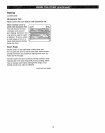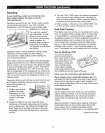
Adjust the Oven Thermostat--
Do It Yourself!
You may feel that your new oven cooks differently
than the one it replaced. We recommend that you
use your new oven for a few weeks to become more
familiar with it, following the times given in your recipes
as a guide.
If you think your new oven is too hot or too cold,
you can adjust the thermostat yourself, tf you think it
is too hot, adjust the thermostat to make it cooler If you
think it is too cool, adjust the thermostat to make it hotter.
We do not recommend the use of thermometers,
such as those found in grocery stores, to check the
temperature setting of your new oven These
thermometers may vary 20-40°F (11-22°C)
To Adjust the Thermostat:
Pull the oven TEMP knob off the range and look at
the back side.
To make adjustment, loosen (approximately one turn),
but do not completely remove, the two screws on the
back of the knob With the back of the knob facing you,
hold the outer edge of the knob with one hand and
turn the front of the knob with the other hand.
(appearance may vary)
To r_ise the oven temperature, move the top screw
toward the right. You'll hear a click for each notch you
move the knob° To lower the temperature, move the top
screw toward the left. Each click wilI change the oven
temperature approximately t0°F (6°C)o [Range is plus
or minus 60°F (33°C) from the arrow.]
We suggest that you make the adjustment one click from
the original setting and check oven performance before
making any additional adjustments.
After the adjustment is made, retighten screws so they
are snug, but be careful not to overtighten. Reinstall
knob on range and check performance.
Air Adjustment Shutter for Oven Burners
The air adjustment shutter for the bottom burner
regulates the flow of air to the flames_
See the Installation Instructions of this manual for
instructions for location and proper adjustment of
the shutter.
The Type of Margarine Will Affect
Baking Performance
Most recipes for baking have been developed using
high fat products such as butter or margarine (80% fat).
If you decrease the fat, the recipe may not give the
same results as with a higher fat product.
Recipe failure can result if cakes, pies, pastries, cookies
or candies are made with low fat spreads. The lower the
fat content of a spread product, the more noticeable
these differences become.
Federal standards require products labeled "margarine"
to contain at least 80% fat by weight. Low fat spreads,
on the other hand, contain less fat and more water.
The high moisture content of these spreads affect the
texture and flavor of baked goods For best results with
your otd favorite recipes, use margarine, butter or stick
spreads containing at least 70% vegetable oil
16


















